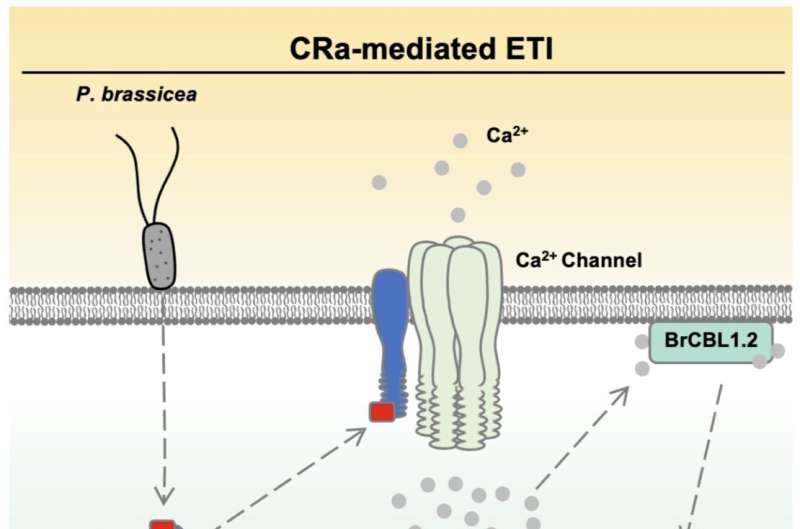This article has been reviewed according to Science X's editorial process and policies. Editors have highlighted the following attributes while ensuring the content's credibility:
fact-checked
peer-reviewed publication
proofread
The molecular mechanisms of Ca²⁺ sensor BraCBL1.2 in clubroot resistance in Chinese cabbage

Chinese cabbage (Brassica rapa L. ssp pekinensis) is one of the most important leafy vegetables cultivated worldwide. Clubroot disease caused by a soil-borne obligate biotrophic Plasmodiophora brassicae (Pb) severely affects the yield and quality of cruciferous crops, especially Chinese Cabbage. BraCRa, as one of the earliest cloned clubroot resistance genes, confers race-specific resistance to Pb.
As TNL-type resistance (R) gene in plant, BraCRa is supposed to induce Ca2+ influx with the help of Ca2+ permeable channel. However, the identity of downstream Ca2+ sensors and decoders of BraCRa are still elusive.
A manuscript entitled "A Ca2+ sensor BraCBL1.2 involves in BraCRa-mediated clubroot resistance in Chinese cabbage" published as article in Horticulture Research.
The aim of this study is to identify the specific isolates of Pb protested by BraCRa and identify the downstream Ca2+ sensor of CRa. In this study, the spatial and temporal expression patterns of BraCRa were investigated by histochemical staining in Arabidopsis. CRa is primarily expressed in root hair cells, and its protein is localized in the cytoplasm and plasma membrane.
Moreover, the researchers screened multiple virulent and avirulent Pb isolates of Chinese Cabbage line CR 3-2, which harbors BraCRa. BraCRa exhibits board-spectrum Pb resistance in B. rapa. Through transcriptomic analysis, the researchers identified a plasma membrane-localized Ca2+ sensor BraCBL1.2 functions downstream of BraCRa upon Pb infection.
Additionally, BraCBL1.2 exhibited similar spatial and temporal expression patterns with BraCRa. Furthermore, the researchers developed a tobacco-based HR assay to prove the involvement of BraCBL1.2 in BraCRa-mediated ETI response. Finally, the researchers verified that overexpression of BraCBL1.2 enhanced clubroot resistance in Arabidopsis.
Therefore, the study demonstrated that BraCRa exerts clubroot resistance in root hair cells of cruciferous plants and identified BraCBL1.2 as one of the downstream Ca2+ sensors of BraCRa during Pb infection.
Collectively, this study identified the involvement of a Ca2+ sensor in BraCRa-mediated clubroot resistance in Chinese cabbage, providing a theoretical basis for further research on the resistance of Chinese cabbage to P. brassicae.
More information: Yinglan Piao et al, A Ca2+ sensor BraCBL1.2 involves in BraCRa-mediated clubroot resistance in Chinese cabbage, Horticulture Research (2023). DOI: 10.1093/hr/uhad261
Journal information: Horticulture Research
Provided by Plant Phenomics




















